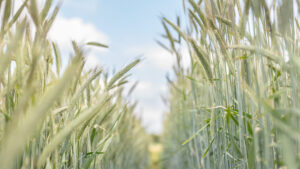While wheat is considered more of a cash crop, does it have the potential to be an effective cover crop?
Wheat is the third largest crop produced in the U.S. following corn and soybeans, but agriculture has always looked at wheat as specifically a cereal crop. What if it has the potential to help with soil management and sustainability goals, as well?
“Fall-planted cereals are widely used as cover crops in the Midwest,” says Amir Sadeghpour, assistant professor of soil management and integrated cropping systems at Southern Illinois University.
Sadeghpour asks: what if, instead of using a traditional cover crop, you substitute different cereals, including wheat? His research centers around using various cereals as a cover crop for corn to secure more residual nitrogen.
“Protecting soil and capturing residual nitrogen are among two of the main purposes for using cereals as cover crops,” Sadeghpour says.
The Illinois Nutrient Reduction Strategy aims to reduce the phosphorus load by 25 percent and the nitrate-nitrogen load by 15 percent by 2025. Cover crops are a strategy that could help to achieve those goals.
From his study, Sadeghpour looks to determine if his team can eliminate nitrogen immobilization that results from late cover crop termination. With proper nitrogen management, he thinks growers might be able to decrease corn’s yield loss following late terminated cover crops.
However, his study is just in the beginning stages. In its first year, the trials will continue for two more years, and Sadeghpour hopes to expand to multiple sites.
“We have multiple soil sampling rounds to track soil nitrogen,” he says. “We’ve tracked soil moisture and temperature, looked at decomposition of cover crops when terminated early and late to assess nutrient release dynamics.
“We are wrapping up our first year and will evaluate the corn yield response to different nitrogen application rates in our cover crop trial.”
With this research, Sadeghpour hopes to find a win-win solution that decreases the environmental footprint while ensuring growers economic gain.
While the SIU researcher tests the advantages and disadvantages of cereals as a cover crop for nitrogen management, others have already been testing cereals to find their effectiveness.
According to the Sustainable Agriculture Research and Education (SARE), winter wheat in particular can be an effective cover crop option. It provides benefits of other cereal crops, as well as a grazing option prior to spring tiller elongation, and it’s less likely than barley or rye to become a weed. It’s also easier to terminate. Additionally, growers are increasingly turning to winter wheat instead of rye because it’s cheaper and easier to manage in spring.
Yet, specialists don’t currently recommend winter wheat as often as winter rye.
“Although wheat is used as a cover crop, especially in areas where wheat is used as a cash grain crop, there are some challenges with it,” says Bert Strayer, cover crop lead for the Western U.S. of La Crosse Seed. “If a cover crop is seeded after a full-term soybean or corn crop and it’s getting late into the seeding season, winter rye is often the better option due to its ease of establishment and superior winter-hardiness.”
Strayer notes that there are some benefits for using a wheat.
“Winter wheat would be a substitute for winter rye especially when specific emphasis is put on forage quality,” he says.
Winter wheat could be beneficial for erosion control, weed suppression and catching nutrients as well, according to SARE.
“Wheat enhances cycling of nitrogen, potassium and phosphorus,” SARE researchers report. “A heavy nitrogen feeder in the spring, wheat takes up nitrogen relatively slowly in autumn. It adds up, however.”
Strayer says that every field is different, though.
“Cover cropping is very situational,” Strayer says. “It depends on what the production system calls for and allows. Depending on the benefits they’re looking for and what time they have available, growers have a number of different options. As an example of a proactive approach, if there’s enough time between late winter and spring planting in a row crop rotation, there could be a cover crop opportunity.”
“There’s not just one way to achieve success with cover crops,” Strayer says. “Neighbors side-by-side of each other could have different goals, and therefore, different cover crop systems.
“As we continue learning, wheat has the potential to become a more important cover crop, but our production system might need modifications.”
Wheat has a bright future ahead of it — as both a cash crop and a cover crop. However, wheat might not be the best cover option until more research comes to light about the possible benefits it can provide.












